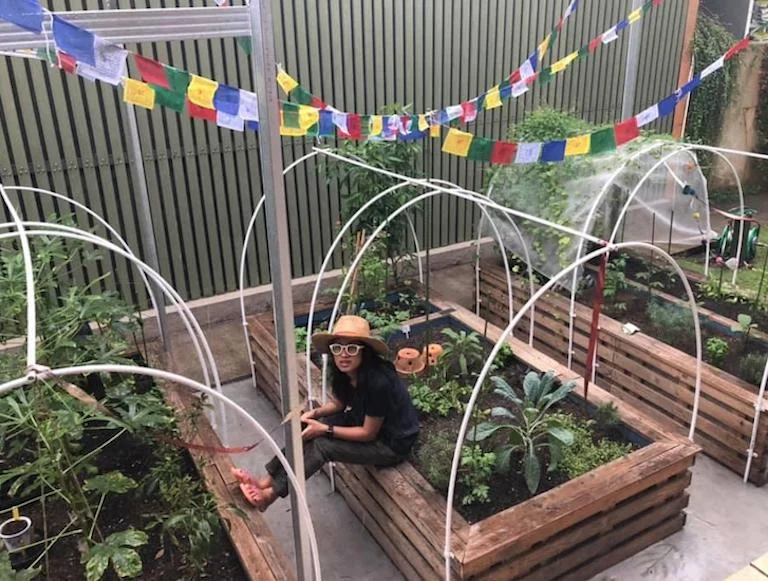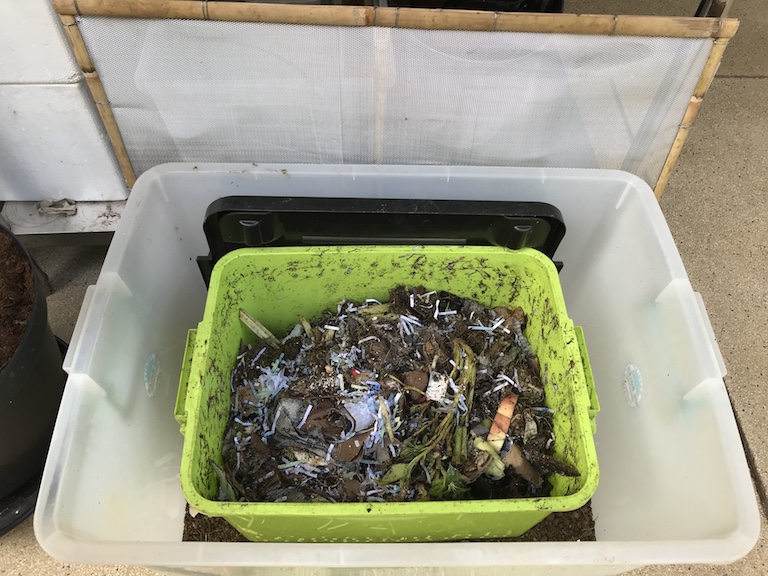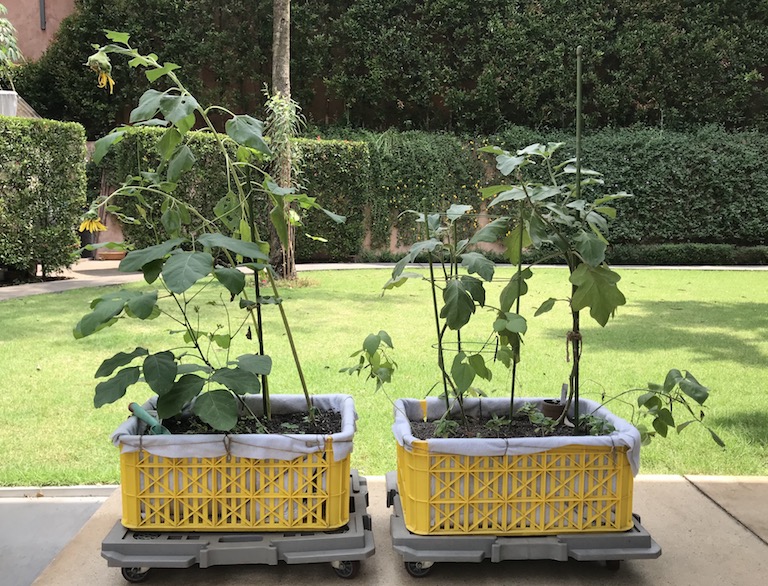Establishing an organic urban garden for your Jakarta home
Weni with Stella the scarecrow
Integrity of food, in particular fresh produce was always my greatest concern when we first moved to Jakarta. Not knowing where things were grown and in what environment made me feel a little uneasy. So to regain the tiniest bit of control of our fresh produce intake, I started growing a few things in my Jakarta garden and this ultimately led to our blog post Growing your own produce in Jakarta .
Today we introduce you to the delightful Weni, a local organic urban gardener who has established a prolific and productive home garden in Bintaro, in the south west of Jakarta. Weni is passionate about growing her own produce, learning through trial and error, all the while sharing this knowledge with those who are keen to learn. In this ajb blog post Weni shares her tips on how to establish a successful urban organic garden for your Jakarta home, regardless of how big or small your available space is.
Happy reading and Happy gardening fellow Green thumbs!
Jo :)
*Kenalkan Weni of Tropical Sage Garden
Weni in her urban garden (photo supplied by Weni)
I was born in Surabaya, East Java. In my last year of high school I moved overseas to study. Upon returning, my son was born and growing our own food and eating healthily became a priority for me. My mother and maternal grandmother taught me a lot about gardening and food, and it’s fantastic to be drawing on this knowledge and extending it further through my own experiences.
First things first, what you do recommend for the structure of an urban garden - raised beds, pots or in-ground planting?
This depends on how much space you have - but as a general rule, I think ‘raised beds’ are most suited for the urban gardener. This is because you can control and manage it better. I actually put ‘planting in pots/containers’ (with a minimum height of 20cm) in the category of ‘raised beds’ because essentially raised beds are anything that is enclosed and above the ground. The gardening principles are pretty similar for both. When building your raised beds, you need to ensure the base of each bed follows the contour of the land as much as possible. This ensures any excess water drains away.
If you choose to plant directly into the earth, you will most likely need to improve the drainage and quality of the soil. Jakarta’s soil is often very dense due to clay, so the method of double-digging is a good idea. Dig to a depth of 0.5 metre (minimum) then take out some of the soil. Add organic matter and mix through with the native soil. Return this to the ground. Allow to rest for a few days before planting.
An example of Weni's raised garden bed, featuring Ceylon spinach (AKA Malabar spinach)
What is the best way to prepare your soil?
Before planting anything, you must ensure your soil is well prepared with good drainage and irrigation (supply of water). Try to incorporate as much organic matter as possible into your soil: cocopeat, fertile soil from a good source (no contamination of pesticides and other chemicals), manure (goat, chicken, cow) and baked/raw rice husks are all fantastic. Many of these can be bought from your roadside garden shops - but be sure to check how they are stored (outside in the rain is not good!)
Vermicompost (worm compost) can be substituted with goat manure (this is easier to source in Indonesia). When you buy your goat manure, you will find that there are two types available: fine granules or coarse. Better that you choose fine granules as it is more suited for urban gardening because it's fast acting. The bigger the chunks of manure, the slower the release of nutrients.
To prepare your soil, use the ratio 1:1:1:1 and mix it thoroughly. Don’t forget to rest the soil for a few days before planting into it.
To prepare your soil, use a ratio of 1:1:1:1 of the above organic ingredients (photo supplied by Weni)
Make sure the organic matter that you buy has been stored well. Prior to use, be sure to leave in the sun to kill any unwanted microbes (photo supplied by Weni)
Can you provide us with some advice on composting?
Everyone should compost. It’s easy to do and it doesn’t take too long to learn. I start by collecting vegetable food scraps (apart from citrus) from my kitchen. We also add coffee grounds and crushed egg shells.
Kitchen scraps
This is then taken outside and placed into our compost tub. To the compost tub we add leaf litter and garden clippings. The compost tub sits on top of a layer of soil and as the food scraps begin to decompose, the nutrient rich liquid seeps into the soil through the holes at the base of our compost tub. Every few days we turn the scraps to ensure they receive more air.
The set up of Weni's compost tub
Notice the holes at the bottom of the compost tub. These allow the nutrient-rich liquid to seep into the soil
Since we are living in a tropical climate, the decomposing process can be as fast as 3 weeks to 2 months depending on how large the heap is and its composition. Once it has thoroughly decomposed (and there is no more heat), I add this to my garden beds.
Another sign that the compost is ready for use is when it no longer smells and it looks like it has totally broken down. It should smell like the rainforest floor.
Ultimately remember this: it’s all about feeding your soil, not feeding the plants. By getting the microorganisms going, you will create a nutritious soil which the plants will love.
If you would like to learn more about composting, get a group of friends together and contact Kebun Kumara. They offer an excellent group workshop on composting.
Can you suggest what to grow and when?
In Jakarta the end of April is a good time to start growing produce as plants are always better with less water than too much water. This is especially true when you’re new to gardening.
Before planting anything, study your area - look at the position of the sun throughout the day. As a general rule, morning sun is always better than afternoon sun.
Be observant - what is already growing in your area? - ie, what is ‘in season’?
Grow local! - particularly in the beginning. Don’t be tempted by ‘exotic seeds’ which are not adapted to Jakarta’s tropical climate.
Some excellent plants to begin with include:
Blue pea flower
Kangkung (water spinach)
Okra
Kemangi & other basil species
Bok choy
Sawi (choy Sum)
Most of the plants listed above grow quickly, and will be ready to harvest in no time!
The climber 'Bunga telang' (Blue butterfly pea plant) is fast growing. The flowers can be steeped in water and used to make tea and other refreshing drinks
- and of course don’t forget to grow your Jakarta Kitchen Staples such as: chilli plants, pandanus (pandan wangi), tumeric and ginger (although these last two take time to grow).
Raised beds featuring kale, basil plants, beans and various herbs
Don’t forget to include some pollinator - attracting plants in your garden. These will help to bring in the bees, butterflies and other 'friendly' insects
We all love tomatoes but they can be tricky to grow in Jakarta. High humidity and high rainfall does not suit tomatoes. You can get around this by growing them under cover, allowing you to control the amount of water they receive.
The laser lite roofing allows greater control of how much water the garden will receive. This is especially important when growing moisture-sensitive plants such as tomatoes
I like to keep a record of when I plant things and when I need to transplant seedlings as well. This helps me manage my garden more efficiently.
Weni's garden whiteboard
How do you minimise pests in your garden?
I do not use any synthetic insecticides in my garden. It’s all about using nature and diversion tactics! Firstly, I like to use Neem oil spray. It is made from oil extracted from the evergreen Neem tree and is useful as a biopesticide for organic gardening as it repels a wide variety of pests. Homemade natural pesticides can easily be found online as well.
Secondly, I use flowers as a decoy. The sunflowers which we grew in tubs (on casters) have attracted very hungry grasshoppers. Instead of spraying them, we have wheeled the flowers away from our main garden and have allowed the grasshoppers to feast on them. Hopefully this means they won’t be interested in the rest of my garden!
Weni's 'decoy' sunflowers
Where do you source your seeds and seedlings?
Firstly, always aim for organic, untreated and non-GMO seeds. My best source for seeds is through seed exchanges. Get to know the person collecting the seeds and observe their garden through photos on instagram, blogs etc. The community of urban gardeners in Jakarta (and beyond) is steadily growing and we not only share our knowledge but also seeds and seedlings. To tap into this, it’s best to follow these accounts on Instagram (see instagram links below for more details).
When I’m travelling to Australia I also love to drop into “Bunnings”. If you’re Australian, you would certainly know this mega store! It has everything!! I pick up packets of heirloom/bio seeds which I know grow well in Jakarta’s tropical climate.
If you’re buying your seeds in Jakarta, pay attention to how the seeds are stored and inquire as to how old the seeds are.
"Sometimes it’s best to grow from seeds, other times it’s better from seedlings. On my workstation wall I have a table that I refer to which gives me an overview of this" - Weni
How do you establish your own Seed Bank?
Each time I grow a crop I save some seeds at the end of harvest and sow them again when the season is right. These seeds which were able to grow in the tropical climate have adapted, and each time I resow them, they will adapt that little bit more. This builds their resilience and makes them more likely to yield a good crop.
Weni picking some butterfly pea flowers for our tea
Seed collecting, ready to include in Weni's Seed Bank
Weni's 'treasure chest' is her seed bank which she keeps in this timber box. The conditions are just right: no direct sunlight and a stable temperature
Where do you source other materials, especially for soil preparation?
I buy things like cocopeat, soil, manure, baked/raw rice husks from the road-side gardening stalls you see all around Jakarta. Once I bring them home I leave them out in the direct sun (bag unopened), to sterilise the contents before using them.
Most of your essential organic materials can be purchased from road-side garden stalls (photo supplied by Weni)
What are your top ‘Essential tools’ and where do you source them?
My essential gardening tools include my pruning scissors, spade and any old kitchen tools.
There’s no one-stop-shop to buy your gardening tools here in Jakarta. You can try Ace hardware or Hypermart or Trubus- this is a home & garden store in West Jakarta which also publishes a gardening magazine.
Some of Weni's preferred gardening tools including two watering cans - the small one is for her seedlings
Do you have any other gardening advice you would like to share?
First and foremost, if you have kids, get them involved!
Gardening is a most rounded education - it involves science, mathematics, problem solving and language. It teaches patience, persistence and encourages curiosity.
Our kids are open minded and can be very receptive to gardening experiences. I truly feel that life moves way too fast even for our children. As a result, their connection with the natural world is weakened due to ‘distractions’. Teaching our children about where their food comes from, how it is grown, and what it tastes like is a fantastic way to encourage them to appreciate and value good food.
Get the kids to grow things that show results quickly, like mung beans for example. They can be grown in cotton wool on the window seal of your kitchen. Other easy things to grow include eggplants and kale.
My son is always growing something. A couple of years ago he grew an avocado tree from a seed. Although this process takes patience, the moment the seed sprouted, a renewed sense of anticipation was felt.
Weni's son observing his avocado seed. A window seal is an excellent place to grow a variety of small plants, allowing your child to take care of their plants each day (photo supplied by Weni)
An avocado plant grown from a seed
Weni, can you please share your favourite sources of gardening information?
Although I refer to lots of instagram accounts as well as web sites, there’s still plenty of room for good books and subscriptions too. Here are some of my recommendations:
Gardening Australia (TV show on Australia Plus network or Youtube)
And don’t forget to travel to places like botanical gardens. Whilst there, take time to explore, observing what grows well and I recommend that you touch the soil (with permission) 👩🏽🌾 You will learn a lot about the texture and composition of productive soil by making close observations.
If you refer to books written for the climate of other places, keep in mind that they are not factoring in the big rains of a tropical climate
This Indonesian publication can be purchased from book stores
Can you recommend your favourite place/s to eat in Jakarta and why?
In fact we mostly cook at home. We love cooking as a family and with our extended family too. I particularly like fast cooking. I come up with things all the time. I like something fresh - even if it’s a curry it will be cooked fast. In one week we might eat Mexican, Italian, and Indian food. My kids take a turn at cooking too. They are 8 and 9 years of age but this is no barrier as we teach them the basics which they can then do for themselves. They are comfortable making a pasta sauce, simple egg dishes and vegetable soup.
Looking at fresh produce anywhere it is grown or sold makes me want to cook. I love going to traditional markets - there’s always wonderful quality produce and a great vibe. And I always try to return more than once to each market. I like to stop and absorb the energy. It’s not just about shopping. It’s about the whole experience.
Weni preparing the flowers for our bunga telang tea
Refreshing teh bunga telang with Belitung lime juice
3 words to describe ‘Your Jakarta’
Urban Organic Gardening
Your favourite place to holiday in Indonesia and why?
Definitely Belitung Island. It’s a mere 45 minute flight from Jakarta yet when you arrive, it’s a different world. You are surrounded by beautiful beaches and it’s relatively quiet. The traditional markets are fantastic as is the local food and beverage.
And finally, what is the best way for our readers to follow your urban organic gardening adventures in Jakarta?
The gardening community in Jakarta (and beyond) is very supportive and generous. If people share their gardening knowledge on Instagram, this means we can all learn from each other. The best way to follow my gardening experiences is through my instagram account: Tropical Sage Garden
Hanging out with Weni in her inspiring garden.
Thank you Weni for sharing your knowledge and passion with a journey bespoke and our Readers too. X
Kenalkan - let me introduce
We have written a few other posts relating to today’s story. Please check them out and let us know what you think! :
Mandira’s Garden : An urban organic garden and cafe in Jakarta
Growing your own produce in Jakarta
Essential herbs and spices for your Jakarta Kitchen
ajb’s Escape to Belitung Island
Words: Jo Stevens and Weni Photography: a journey bespoke and Weni































